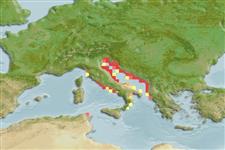>
Acipenseriformes (Sturgeons and paddlefishes) >
Acipenseridae (Sturgeons) > Acipenserinae
Etymology: Acipenser: Latin, acipenser = sturgeon, 1853 (Ref. 45335).
Eponymy: Fortunato Luigi Naccari (1793–1860) was an Italian philosopher, librarian and professor of natural history. [...] (Ref. 128868), visit book page.
More on author: Bonaparte.
Environment: milieu / climate zone / rango de profundidad / distribution range
Ecología
marino; agua dulce; salobre demersal; anadromo (Ref. 51243); rango de profundidad 10 - 40 m (Ref. 93286). Temperate; 46°N - 37°N, 10°E - 20°E
Europe: Adriatic Sea and its tributaries between Po (Italy) and Buna (Albania) drainages. Recorded from Corfu; present in lowermost part of Adriatic rivers from Soca to Drin. Records from Tyrrhenian slope of Italy, Spain and France are erroneous.
Tamaño / Peso / Age
Madurez: Lm ? range ? - ? cm
Max length : 200 cm TL macho / no sexado; (Ref. 3397); peso máximo publicado: 25.0 kg (Ref. 3193)
Espinas dorsales (total) : 0; Radios blandos dorsales (total) : 36 - 48; Radios blandos anales: 24 - 31. Snout moderate, very broad and rounded at tip. Lower lip continuous, interrupted at center. Barbels nearer to tip of snout than to mouth and not touching it. Five rows of scutes, dorsal 10-14 (the middle ones deeper and usually larger than those at front), lateral 32-42 on each side, ventral 8-11 on each side, with no smaller plates between dorsal and lateral rows. Back is olivaceous brown, flanks lighter, belly white.
Body shape (shape guide): elongated; Cross section: circular.
Occurs in the sea close to shore and estuaries, not entering pure marine waters. In freshwater, it inhabits large deep rivers (Ref. 59043). A long-lived species which is found mainly over sand and mud. Feeds on bottom-living invertebrates and small fishes. Reproduction takes place from May to July. Is threatened by habitat destruction, pollution and overfishing (Ref. 26100). The flesh is used for food (Ref. 6866) and eggs used for caviar production (Ref. 128183).
Enters rivers from March to May, and presumably spawns then.
Kottelat, M. and J. Freyhof, 2007. Handbook of European freshwater fishes. Publications Kottelat, Cornol and Freyhof, Berlin. 646 pp. (Ref. 59043)
IUCN Red List Status (Ref. 130435: Version 2024-2)
Threat to humans
Harmless
Human uses
Pesquerías: comercial
Herramientas
Special reports
Download XML
Fuentes de Internet
Estimates based on models
Preferred temperature (Referencia
123201): 14.7 - 18.2, mean 17.4 °C (based on 12 cells).
Phylogenetic diversity index (Referencia
82804): PD
50 = 0.5000 [Uniqueness, from 0.5 = low to 2.0 = high].
Bayesian length-weight: a=0.00295 (0.00131 - 0.00665), b=3.18 (3.00 - 3.36), in cm total length, based on LWR estimates for this Genus-body shape (Ref.
93245).
Nivel trófico (Referencia
69278): 3.4 ±0.50 se; based on food items.
Resiliencia (Referencia
120179): Muy bajo, población duplicada en un tiempo mínimo superior a 14 años (Preliminary K or Fecundity.).
Fishing Vulnerability (Ref.
59153): Very high vulnerability (90 of 100).
🛈
Nutrients (Ref.
124155): Calcium = 16.9 [10.0, 29.8] mg/100g; Iron = 0.256 [0.156, 0.410] mg/100g; Protein = 17.5 [14.9, 20.1] %; Omega3 = 0.33 [0.18, 0.59] g/100g; Selenium = 18.3 [9.3, 35.5] μg/100g; VitaminA = 6.4 [2.3, 17.8] μg/100g; Zinc = 0.53 [0.38, 0.73] mg/100g (wet weight);
